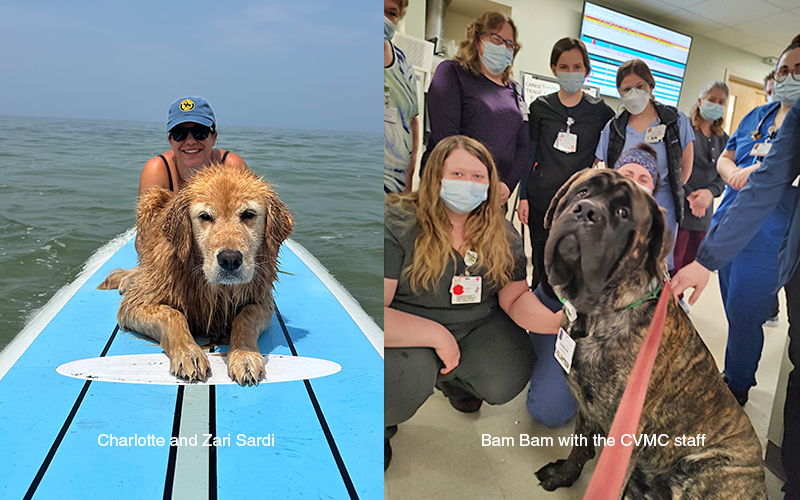This morning morning, January 4, Warren resident Brian Carten will bring Bam Bam, his two-year-old therapy-certified English mastiff, to Moretown Elementary School. Then, they will visit Central Vermont Medical Center (CVMC) in Berlin, and finally end their day with a visit to Crossett Brook Middle School in Duxbury.
During these visits, students, patients, and health care staff will gather around Bam Bam to pet him, hug him, talk to him, and play with him. “They might acknowledge me,” Carten said, “but usually people will have a conversation with the dog like I’m not even there.”
Yet, the two of them form a therapy dog team, visiting and volunteering at up to four settings per week – including the CVMC nursing home Woodbridge, Vermont courts, and other local schools where Bam Bam provides affection, comfort, and support to people.
GRATIFYING WORK
Warren resident Zari Sadri, who is part of a team with her six-year-old golden retriever Charlotte, said she got interested in getting Charlotte certified after learning about some of Carten’s work – especially that Carten and his English mastiffs were providing support to students at Harwood Union High School after five local teenagers were killed in a wrong-way crash on I-89 in 2016.
Sadri and Charlotte have volunteered at the Burlington nursing home Elderwood and in afterschool programs through the Waterbury Park and Recreation Department. “Essentially, Charlotte has just been an angel of a dog her whole life,” Sadri said. “She was an easy puppy, always well behaved, and loves to interact with people.”
“I knew I wanted to share her with people,” Sadri said.
Carten and Sadri both said that working with therapy dogs is gratifying. Carten recalled visits at the CVMC cancer unit, where he said staff loved spending time with his dogs.
Although he said it’s been overwhelmingly positive since he started volunteering in 2013, the work can come with some challenges.
“Hearing certain testimony in court rooms, or walking into a hospital room where someone you know is passing away – sometimes there are certain things that can definitely affect you. How can it not?” he said.
Sadri agreed. “It’s important to consider that side of it,” she said.
PASSING THE EXAM
Both Carten’s and Sadri’s dogs are certified via the nonprofit organization Therapy Dogs of Vermont (TDV). Carten said that dogs must be at least one year of age, and with their handlers for at least six months before they qualify.
The certification process requires testing. In one portion, dogs are exposed to various stimuli in order to evaluate their reactions – with six people hugging a dog at once, or petting their laps to see if a dog jumps up. Carten said that to pass the test, a dog can’t be aggressive in any way. “In the ER, someone might be agitated, or something like that. You don’t know what you’re going to come across during visits,” he said.
“They’re basically tested on their ability to recover in stressful situations,” Sadri said.
If a dog fails a test, handlers can work with their dogs on certain behavioral issues, then have their dog re-test, Carten said. “Some dogs have to take the test three or four times, and end up being great therapy dogs,” he added.
Sadri’s Charlotte, who was certified last year, passed her test on the first try. But this was after Sadri observed a test session that one of Carten’s dogs underwent, then worked with Charlotte to get her to stop pawing – as when a dog offers their paw in exchange for a treat.
Although handlers can work with dogs on some behavioral issues, Carten said that temperament cannot exactly be trained. “A dog needs to be friendly, with basic obedience, and somewhat outgoing – but not extremely so, where dogs are interacting with each other inside of facilities,” he said.
Of handlers, Carten said that “you’re being tested as much as the dog is – on how you react to how the dog reacts.”
Sadri said that it comes down to whether a dog is respecting the handler and whether the handler is understanding the dogs’ needs – how long a dog is able to provide support, what kinds of social interactions they thrive in, and what exhausts them. In that way, Sadri said that volunteering with Charlotte has bonded them.
JUST A SINGLE DOSE
Carten said that before the COVID-19 pandemic broke out, TDV had over 300 certified handler and dog teams, and that now they are down to about 190. “We desperately need more teams,” he said. “I can’t fill the need in the local school system myself.”
Many studies now show considerable stress reduction among students of all ages after interacting with therapy dogs in educational settings. The same is true for patients, residents, and staff in care settings. In a 2023 study published in “The Humanistic Psychologist,” a residential facility for men in recovery from substance use introduced sessions with therapy dogs and the authors concluded that “even a single dose of Animal-Assisted Activities (AAAs) has been shown to provide relief from anxiety and stress.”
Carten said interested dog owners should get on TDV’s website to sign up for a ‘clinic,’ where staff will provide information about testing and certification, and give people advice about what they might work on with their dogs, in terms of behavior
He emphasized that in Vermont, there are more programs and institutions accepting visits from therapy dog teams than there are teams themselves. “I do this a couple days a week, and I’ve only scratched the surface,” he said.













